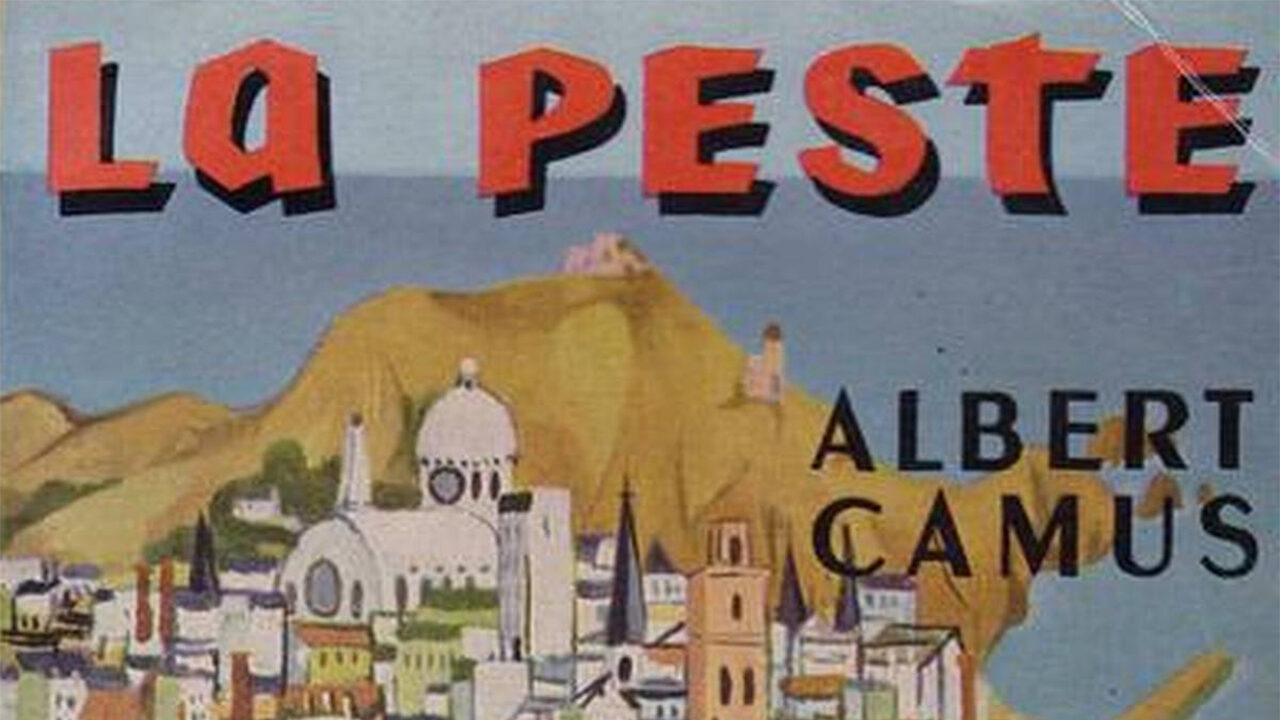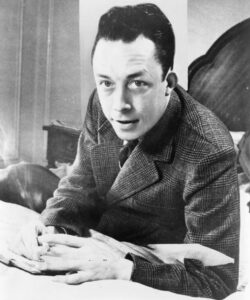
The existence of political authority must, ultimately, lead to murder: That is the message at the heart of Albert Camus’s novel, La Peste, or, as it is known in English, The Plague. Interest in the book has renewed during the COVID-19 pandemic, but its seditious quality has generally passed unnoticed.
Recent commentators have chosen, understandably, to emphasize aspects with obvious parallels to our present reality. But The Plague is, at its core, a fierce condemnation of authority as domination, with an understanding that as long as it exists, we are susceptible to pestilences—both those that incubate in the human body and those that fester in the human heart.
First published in 1947, Camus’s novel is the fictional chronicle of a plague that strikes the French Algerian city of Oran sometime in the 1940s. It has often been interpreted as a symbolic rendering of the German occupation of France and the gaping wounds left in French society. While Camus’s experiences during the occupation and as a member of the Resistance undoubtedly influenced The Plague, to construe its narrative as a simple allegory would unjustly limit the breadth and depth of its social critique. It is telling that Camus chose to set the novel, not in a totalitarian state, but in the liberal-democratic yet still deeply unequal and segregated environment of French Colonial Algeria. The plague which devours Oran is less a proxy for a manifestly odious occupying force than it is emblematic of the contradictions inherent in democracy, in which the limits of liberal universalism and equality collide against the violent reality of state power.
While Camus’s experiences during the occupation and as a member of the Resistance undoubtedly influenced The Plague, to construe its narrative as a simple allegory would unjustly limit the breadth and depth of its social critique.
As the novel opens, the citizens of Oran are depicted as almost entirely absorbed in the well-established daily rounds of work and habit: “[T]heir chief interest is in commerce,” the narrative indicates, “and their chief aim in life is, as they call it, ‘doing business.’” The outbreak of plague disrupts this drone-like routine; it drags the people of Oran out of the realm of familiarity and into a terrifying realization of their own mortality, compelling them to reconsider what truly matters in life. The individual’s confrontation with the reality of death—and the questions about meaning and authenticity this engenders—is the central concern of existentialist philosophy, of which Camus’s essay The Myth of Sisyphus was a seminal expression. Little surprise, then, that The Plague is taken as another classic of existentialist literature.
But that label must not blind us to the novel’s still broader philosophical concerns. As much as The Plague is concerned with death and meaning, it is even more concerned with murder and the ways authority is used to legitimize it. The deep concern with lethal violence pushes the novel beyond existentialist individualism, in the direction of a profound social inquiry.

Albert Camus in 1957, the year he won the Nobel Prize in Literature.
Indeed, even as the first disease-bearing rats appear on the streets of Oran, the reader’s attention is drawn to a different, social plague of injustice and indifference. After the protagonist and narrator, Dr. Bernard Rieux, returns from saying good-bye to his wife at the train station, he meets the Parisian journalist Raymond Rambert, who has been tasked with writing a report on the living conditions of the city’s Arab population. Rieux tells Rambert that the conditions are not good, but before he will say any more, demands to know if Rambert would be able to “publish an unqualified condemnation of the present state of things.” When Rambert equivocates, Rieux refuses to offer him any more information, saying he has “no use for statements in which something is held back.”
Amused by this, Rambert accuses him of speaking “the language of Saint-Just,” the Jacobin ideologue who played a key role in the advent of the Reign of Terror. Rieux, however, rejects the association. He is simply “sick and tired of the world he lived in—though he had much liking for his fellow men—and had resolved, for his part, to have no truck with injustice and compromises with the truth.” Their brief exchange establishes clearly and succinctly the conflict that will define the rest of the novel. Confronted with an injustice that threatens human life, Rieux resolves to combat it as best he can—by rejecting state violence, by showing compassion for his fellow humans, and, above all, by committing to tell the truth no matter what the cost.
Unfortunately, Oran’s civic leadership has a far less stringent attitude towards the truth. As the plague begins to claim its first victims, and the epidemic worsens, Rieux, “by dint of a persistence that many thought ill-advised,” convinces the city’s medical and political authorities to convene a meeting to address the growing crisis. The city’s officials, however, are loath to even hear the word plague uttered, since an outbreak of plague would compel them “to take very drastic steps” that might cause a panic and undermine their authority. Led by Dr. Richard, the chairman of the town’s medical board, the committee reproaches Rieux for painting “too gloomy a picture,” arguing that it could not be known for certain that it was plague. Rieux, unimpressed, warns the committee that if they fail to act quickly to put prophylactic measures into place, “half the population may be wiped out.”
Confronted with an injustice which threatens human life, Rieux resolves to combat it as best he can—by rejecting state violence, by showing compassion for his fellow humans, and, above all, by committing to tell the truth no matter what the cost.
After some further verbal sparring, Richard and the authorities resolve “to take the responsibility of acting as though the epidemic were plague.” Disgusted by this dishonest and dangerous approach, Rieux leaves the meeting, only to encounter one of the first victims of the committee’s indifference just a few minutes later: “a woman screaming in agony, her groin dripping blood.” For those in positions of authority, the truth must be made to conform to what they consider to be necessary, even when it means death for half the people they are supposed to be serving.
Though the plague only worsens, the municipal authorities’ response continues to oscillate between lethargic inaction and violent authoritarianism. (To draw contemporary parallels seems superfluous.) Rieux sums up their failure with a derisive exclamation: “Orders… when what’s needed is imagination.” Even as the plague grows so serious that it can no longer be ignored and the city is quarantined, the local government opts for a response that is as much military as it is medical. Many families, not trusting the government and not wishing to be parted with their plague-stricken loved ones, refuse to cooperate with quarantine measures. The city responds with violence—with “batterings on the door, action by the police, and later armed force,” and patients “taken by storm.”
Forced to participate in this charade of coercion masked as medicine, Rieux falls into deep psychological stress. One evening, standing beneath the statue of the Republic, all he can feel is “a bleak indifference steadily gaining on him” as the gears of state power gradually grind his compassion down into dust. Rieux, who began the story by firmly condemning injustice out of a genuine feeling of empathy for his fellow humans, finds he no longer needs to “steel himself against pity,” for “one grows out of pity when it’s useless.”
Rieux’s humanity, fortunately, will ultimately be salvaged by the intervention of Jean Tarrou, a disillusioned political radical who arrived in Oran shortly before the plague began. As cases continue to rise and the city’s medical infrastructure is increasingly overwhelmed, the city’s leaders begin to contemplate conscripting the prisoners in the town jail to perform sanitary services. Upon hearing this, Tarrou comes to Rieux with a proposal. Tarrou does not wish to leave the response to the plague to the authorities alone, in part, because he believes that “[o]fficialdom can never cope with something really catastrophic,” but even more important, because he “loathe[s] men’s being condemned to death.” Tarrou proposes that instead he and Rieux, outside of the realm of officialdom, organize volunteers into sanitary squads to help fight the plague. They escape the murderous dichotomy between the plague and state violence imposed upon Oran by the authorities, and Rieux rededicates himself to the task of fighting injustice, not with power, but with compassion.
Much later, as the epidemic reaches its peak, another conversation between Rieux and Tarrou reveals the deeper criticism of contemporary society behind Tarrou’s efforts. He begins by telling Rieux about his father, a kind man with a strange passion for the railway directory, who served as a prosecuting attorney. One day, when Tarrou was a teenager, his father invited him to observe one of his court cases, and Tarrou was forced to look on in shock as this affectionate, peculiar man transformed into a red-robed monster, cruelly demanding the death of another man. From that moment on Tarrou realized that the whole “social order… was based on the death sentence,” on “murder in its most despicable form,” and resolved to struggle against this profoundly unjust order.
Yet after witnessing an execution in Hungary, Tarrou came to realize that, in attempting to put an end to murder, he had himself aided in committing many murders—that he, in his own words, carried the plague: not the biological scourge but a contagion of politics, a virus of authority which renders the human conscience mute and human life worthless. In Tarrou’s disillusioned view, almost everyone in the world suffers from plague, for all of us have the capacity to harden our hearts to others’ suffering and claim the right to punish and kill; in short, to become “a rational murderer.”
The only remedy for this fatal condition that Tarrou can propose is to recognize “that on this earth there are pestilences and there are victims, and it’s up to us, so far as possible, not to join forces with the pestilences,” to follow not the path of domination, but “the path of sympathy.”
In Tarrou’s disillusioned view, almost everyone in the world suffers from plague, for all of us have the capacity to harden our hearts to others’ suffering and claim the right to punish and kill; in short, to become “a rational murderer.”
The plague begins to ebb away, though not without carrying off Tarrou in one of its last spasms of violence. When it ends—as abruptly as it began—the cruelty and injustice it brought to the fore remain. Shortly after the quarantine is lifted, a character who was about to be arrested before the plague struck, loses his mind and starts firing a gun randomly out of his window. Rieux observes as the police dislodge him from his house using a machine gun, and then brutally beat him in full view of an onlooking crowd. As Rieux walks away, off to see another patient, he cannot get “the dull sound of fists belaboring the wretched man’s face,” out of his head.
Returning to the spot where he and Tarrou had spoken months before, and staring out over the city, Rieux decides to write a chronicle of the plague to commemorate all those who, in a spirit of mutual aid and freedom, join in “the never ending fight against terror,” and “despite their personal afflictions… strive their utmost to be healers.” At the same time, he knows that just as “the plague bacillus never dies or disappears for good,” neither does the threat of organized violence. It always lurks behind the veneer of legitimacy that authority grants it: “Perhaps the day would come when, for the bane and the enlightening of men,” the plague “would rouse up its rats again and send them forth to die in a happy city.”
